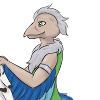
Day 3 of Inktober - Poison
When most people see a snake, they think of venom - a handy, natural way for many snakes to easily kill their prey. No one thinks 'poison' when they see a mouse, but the truth is, in the Northeast U.S. you're more likely to find a rodent full of poison than you are a venomous snake.
Rodenticides are wreaking havoc on wildlife. Like most poisons humans put into the environment, they rarely kill only the pests we aim for. Rat and mouse poisons stay in the bodies of sick and dying rodents, who wander out of your house and into the waiting talons of a screech owl, or mouth of a garter snake, which are sickened or killed when they feed on the poisoned carcass. Ironically, by killing a few mice with rodenticides to rid your house of pests now, you're causing a population boom of rodents later when the predator populations are killed off by your careless use of poison. White-footed mice are also a prime carrier of the bacteria that causes Lyme Disease, and are a favorite host for the Deer Ticks that transmit it from the mouse to humans.
If you have a mouse problem, use a snap trap or live-capture trap. Poisons do much more harm than good.
Holbein ink with a nib and brush on Bristol, 6.5X11 inches.
When most people see a snake, they think of venom - a handy, natural way for many snakes to easily kill their prey. No one thinks 'poison' when they see a mouse, but the truth is, in the Northeast U.S. you're more likely to find a rodent full of poison than you are a venomous snake.
Rodenticides are wreaking havoc on wildlife. Like most poisons humans put into the environment, they rarely kill only the pests we aim for. Rat and mouse poisons stay in the bodies of sick and dying rodents, who wander out of your house and into the waiting talons of a screech owl, or mouth of a garter snake, which are sickened or killed when they feed on the poisoned carcass. Ironically, by killing a few mice with rodenticides to rid your house of pests now, you're causing a population boom of rodents later when the predator populations are killed off by your careless use of poison. White-footed mice are also a prime carrier of the bacteria that causes Lyme Disease, and are a favorite host for the Deer Ticks that transmit it from the mouse to humans.
If you have a mouse problem, use a snap trap or live-capture trap. Poisons do much more harm than good.
Holbein ink with a nib and brush on Bristol, 6.5X11 inches.
Category Artwork (Traditional) / Animal related (non-anthro)
Species Unspecified / Any
Size 1000 x 586px
File Size 296.9 kB
Yeah, bioaccumulation is a horrible, horrible thing, one of a hundred reasons why being a predator is a rough, ugly life, and why I've considered them far more protagonist than villain.
It's just this reason that, the time I found a big rat snake on a two-lane road out in Southern Illinois, I picked it up gently, took it off the road and found a nice big warm rock for it to curl up on. Didn't even put up a fuss about me picking it up.
It's just this reason that, the time I found a big rat snake on a two-lane road out in Southern Illinois, I picked it up gently, took it off the road and found a nice big warm rock for it to curl up on. Didn't even put up a fuss about me picking it up.
Oh, ABSOLUTELY. Rat snakes are completely harmless, not at all aggressive, and beneficial to pretty much anything in the vicinity that depends on plants, including some of its own prey. (Keeping mouse and sparrow numbers down keeps their population from exploding, which in turn ends in mass starvation). The one thing I worried about was that it might have been a water moccasin (I didn't know my snakes that well) but the non-aggressive posture reassured me enough to try it.
Oh yes, the mice are also victims. Rat poison is a horribly painful way to die, and there are much more humane options. Snap traps instantly kill the animal (if used correctly). There's also the risk of other animals and children getting into rat poison - it's brightly colored and tastes sweet, which makes it attractive to children.
Yes! I spoke with a storage facility that I used to use a few years back, since I noticed poisons around for rodents. A couple of months later, they switched to snap traps! They started investing in those sonic sound stake things when I left, but I don't see those working for them. Anyway, I generally try to sway people away from using poisons for this exact reason!
I made this post on facebook:
I don’t want to post anything upsetting or whiny, I just wanted to post about a topic that came up earlier…
As you probably know, most rodenticides (rat poisons) inhibit coagulation of the blood, by interrupting the vitamin K cycle, eventually resulting in hæmorrhage. Over the course of several days, the animal will become increasingly weak, and blood will gather in the abdomen and lungs, and leak from orifices, including the eyes. The poison is (more often than not) eaten by more animals than just rats, with potential risks being posed anywhere from mice and voles, to pets and children. Secondary poisoning is also a legitimate risk to predators and scavengers, both wild and domestic (some poisons remain potent in the dead or dying animal, which can be passed on to animals that consume this easy prey). If a quantity large enough to reach a lethal dose is consumed, the secondary victim will incur the same effects as the first (posting a picture of an owl bleeding from its eyes would be unnecessary, but would act as an example of a potential outcome of using poison). Paradoxically, if enough predators are affected, it could even cause an eventual increase in pest population. I am sure much of this is already known, plus I am obviously not a specialist, so I recommend that people do their own research, and make their own choices, but please don’t use poison without thought.
Although it doesn’t discuss the subject fully, I thought this site had some interesting information: http://www.merckvetmanual.com/toxic.....-and-congeners
I don’t want to post anything upsetting or whiny, I just wanted to post about a topic that came up earlier…
As you probably know, most rodenticides (rat poisons) inhibit coagulation of the blood, by interrupting the vitamin K cycle, eventually resulting in hæmorrhage. Over the course of several days, the animal will become increasingly weak, and blood will gather in the abdomen and lungs, and leak from orifices, including the eyes. The poison is (more often than not) eaten by more animals than just rats, with potential risks being posed anywhere from mice and voles, to pets and children. Secondary poisoning is also a legitimate risk to predators and scavengers, both wild and domestic (some poisons remain potent in the dead or dying animal, which can be passed on to animals that consume this easy prey). If a quantity large enough to reach a lethal dose is consumed, the secondary victim will incur the same effects as the first (posting a picture of an owl bleeding from its eyes would be unnecessary, but would act as an example of a potential outcome of using poison). Paradoxically, if enough predators are affected, it could even cause an eventual increase in pest population. I am sure much of this is already known, plus I am obviously not a specialist, so I recommend that people do their own research, and make their own choices, but please don’t use poison without thought.
Although it doesn’t discuss the subject fully, I thought this site had some interesting information: http://www.merckvetmanual.com/toxic.....-and-congeners
Thank you for helping to bring poison use to peoples' attention. Too many people are ignorant of the effects of poisons like rodenticides and have a 'not my problem' attitude once the mouse or rat is dead. Not only does it harm the environment as a whole (which we are all a part of), but it causes their mouse or rat problem to get exponentially worse. And as we all know when it comes to breeding, 'exponential' is a fitting term for rodents.
It's also painfully easy to simply choose a different type of trap. Snap traps are actually more economical because you can reuse them over and over. Live-capture traps are even better because you don't have to deal with a dead rodent - you just bring the trap somewhere away from your home, open the trap, and watch the rodent run off.
Poisons are unnecessary and overly expensive compared to other methods.
Poisons are unnecessary and overly expensive compared to other methods.

 FA+
FA+












Comments